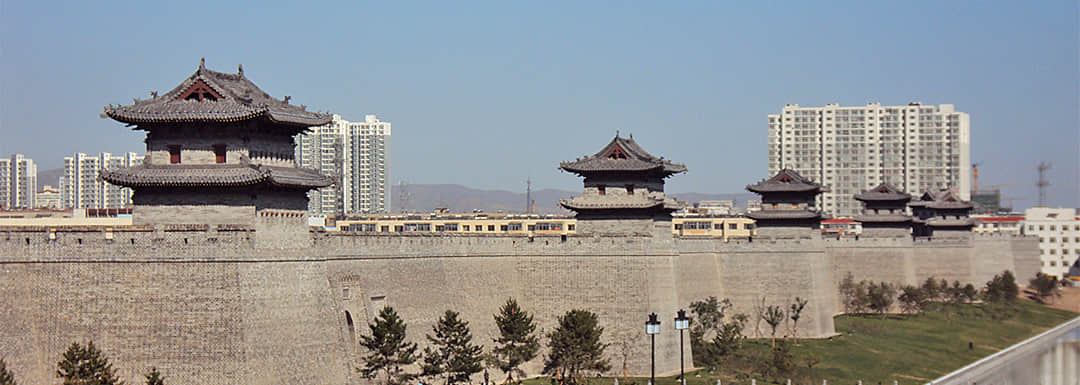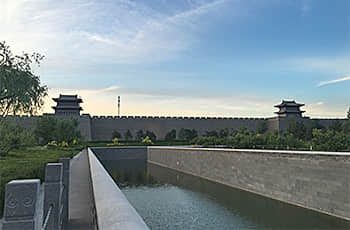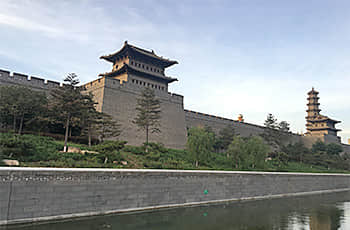Datong Ancient Rampart

The ancient rampart was built in 1372 CE, and was based on the Yuan Rampart. The wall is tall, majestic and sturdy. It can be tightly guarded and well-equipped. It is a famous city in the history of ancient military architecture in China. A major feature of the Datong Ancient Rampart is that the outer profile is like a gear with extruding piers. That is a special and unique guardian design.
- Chinese name: 古城墙 gǔ chéng qiáng
- Suggest time: 1-2 hours
- Ticket: free
- Address: Pingcheng District, Datong, Shanxi Province
- Open hours: 06:00-24:00 (for spring and autumn), 05:00-02:00(summer); 07:00-22:00 (for winter)
- Best time to visit: all year around
- How to get there:
Take bus No. 35 from Datong City to the Crossing of Yongtai Road and Jiaochang Street Station or get off at Yongtaimen Station. The south Ancient Rampart is within walking distance.
Take bus No. 38, 27 or 59 and get off at Heyangmen North or Heyangmen South Station to reach east Ancient Rampart.
Take bus No. 35 and get off at Renmin Square to reach north Ancient Rampart.
Take bus No. 4, No. 6, No. 23, No. 27, No. 28 or No. 38 and get off at Qingyuan West Station and reach west Ancient Rampart.
Highlights of the Rampart
Jian Lou (Embrasured Watchtower) 

The Embrasured Watchtower is a two-story saddle roof traditional wooden structure with a height of 19 meters and a building area of 800 square meters. It is built on the top of the structure called Yuecheng, which is the front line of defense. Defending forces would have gathered here to counter the invasion. As the outer wall and the left and right sides have openings for shooting arrows, it is called Jian Lou (literally Arrow Building).
Wang Lou (Watchtower)
The Watchtower is a two-story traditional wooden building with a height of 12 meters and a building area of 180 square meters. Built on Ma Mian (docks), it is the main place for the station of soldiers, observation of enemies, and defense of the city.
Weng Cheng (Urn City)
The small city outside the main city gate is rectangular and covers an area of 5,100 square meters. It is an important part of the city gate defense. In the old times, soldiers lured enemies in and annihilated them from the top of the walls. Troops could also be stationed there.
Yue Cheng (Mechanical City)
Yue Cheng is a small city that shields the gate of Weng Cheng outside the city gate and controls the drawbridge over the city moat. Its area is 12,000 square meters. It is called Yue Cheng (literally Lunar City) for its shape.
Wenfeng Tower 

Wenfeng Tower, commonly known as the Wild Goose Pagoda, is located in the eastern section of the south Ancient Rampart that was built in 1624 CE in the Ming Dynasty. The 37-meter high octagonal seven-level tower is hallowed. The brick tower imitates the shape of a wooden structure. There are brick ladders in the tower for going up and down. Observation windows for all directions intertwine in all layers. Its shape is stable and exquisite, which is rare for an ancient city wall in China.
Qian Lou (Earth Building)
Qian Lou sits on the northwest corner of the city wall, and is a five-story cross-top wooden structure. Its base is 1.6 meters. The total height is 43 meters and it covers an area of 2083 square meters, and is the top point of the ancient city wall. It gets its name from the ‘Earth’ position of 12 positions as in the “Eight Diagrams”. Its tall convex architectural features enable observation and defense of detoured attack from the enemy in a war. It is just too powerful for the whole structure, and it is also called Zhen Lou (powerful building). In autumn, people can really appreciate the scene on the building. They say Zhen Lou in Autumn is one of the Top Eight Scenes in Datong.
Jiao Lou (Corner Building)
Jiao Louis a two-story cross-top Chinese traditional wooden structure. It is 17 meters high and built on the corner. The exterior is convex, and it overlooks the land and has a wide view. People can clearly observe the enemy. It is another important facility for the fortification of the city wall.
Drop us a line and we'll connect you with the top China expert in no time!